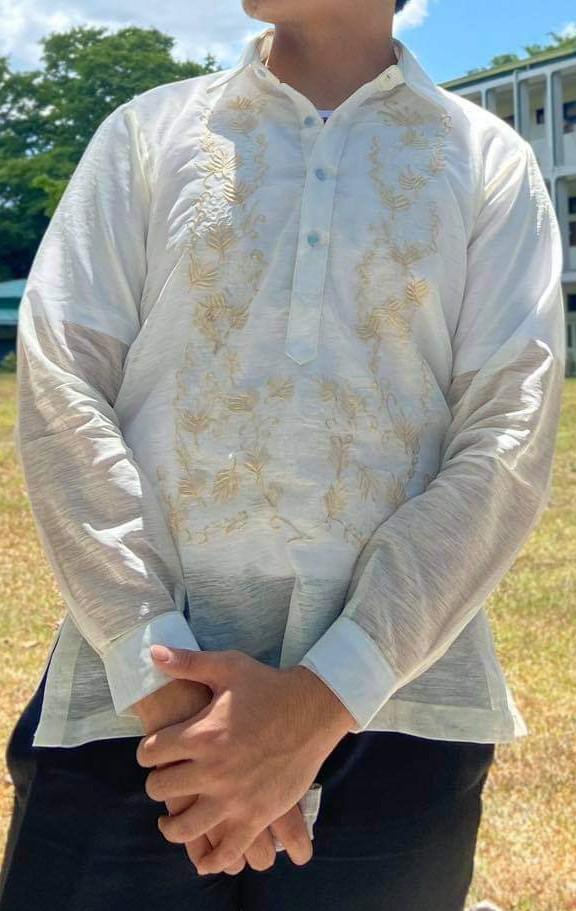A Biased View of Where To Buy Barong Tagalog Near Me
Table of ContentsThe Of Barong Tagalog For FemaleThe Best Guide To Modern Barong TagalogGetting The Barong Tagalog Stores To Work

The term is generally not utilized.
Rather, the name was created to differentiate the dress as indigenous (hence "tagalog", i. e. ), rather than the styles of gown of Europeans and also other international cultures. Description [edit] Barong tagalog used with a salakot. The female is using a. Barong tagalog is an official t-shirt normally made of sheer lightweight but rigid fabric recognized as (usually woven from pia or abac fibers).
The term camisa de chino is additionally utilized for collar-less and cuff-less shirts, called after its similarity to tee shirts put on by Chinese laborers. It is used with belted trousers and gown footwear. Headwear, when worn, is either a salakot or a buntal hat (as well as traditionally likewise leading hats or bowler hats). Barong tagalog can vary significantly in regards to layout as well as product used, yet they share usual qualities of having long sleeves, needlework, being buttoned (halfway or directly down the upper body), and also the absence of pockets. They are likewise used loosely and have slits on both sides. Historically, the material made use of for barong tagalog depended upon the social class of the user and also the procedure of the celebration.
The Single Strategy To Use For Where To Buy Barong Tagalog Near Me

The quality of the material and also the intricacy of the needlework were frequently signs of the condition and also wide range of the wearer. The needlework of the barong tagalog are typically put on a rectangular section on the front of the breast (called pechera, "shirt front", from Spanish pecho, "upper body"), and/or over the entire t shirt (sabog, from Tagalog for "scattered"). explanation.
Amongst Tagalog guys, they were typically matched with a rectangle of highly enhanced fabric referred to as the salaual or salawal worn knee-length as well as formulated in the center (like an Indian or Thai and also Cambodian ); while in females they were coupled with a wraparound skirt referred to as the.
, aside from similar baro (which had much shorter sleeves) as well as salaual combinations, males also used vivid robe-like as well as coat-like versions that can prolong to well below the knees (understood as the marlota and baquero in Spanish, respectively). These were in some cases belted at the midsection.

The Of Where To Buy Barong Tagalog
The couturier Jose "Pitoy" Moreno has actually hypothesized that this transitional design of t-shirt was the camisa de chino of later centuries, that makes it a forerunner to the barong tagalog. Depictions of participants of the top classes (including citizens as well as) in the 18th century showed that they invariably wore European-style clothes. click to read.
These were a lot longer than the contemporary barong tagalog, getting to down to a little over the knees. They were also frequently striped with vibrant shades like blue, red, or dig this eco-friendly. Nonetheless, they currently displayed trademarks of the modern barong tagalog, consisting of being made from large nipis product, embroidery, lengthy sleeves, as well as a loose shape with slits on both sides - over here.
Early instances of barong mahaba generally had high-standing collars or even Elizabethan-style ruffs with slim cravats. Barong mahaba were typically used with colorful straight-cut pants with stripes, checkers, or plaid-like patterns (usually made from imported cambaya, rayadillo, as well as guingn materials), stovepipe hats (sombrero de copa), and a sort of embroidered velour or natural leather slip-on footwear referred to as corchos. The large fabric utilized by barong mahaba also required the putting on of an underwear, called camisn or camiseta, which was also worn on its very own by citizens. By the 1840s, barong mahaba mainly fell out of fashion. In this period, it progressed right into the modern-day "traditional" barong tagalog, being much shorter with much less extravagant folded up collars, while still preserving the large material and other baro attributes.